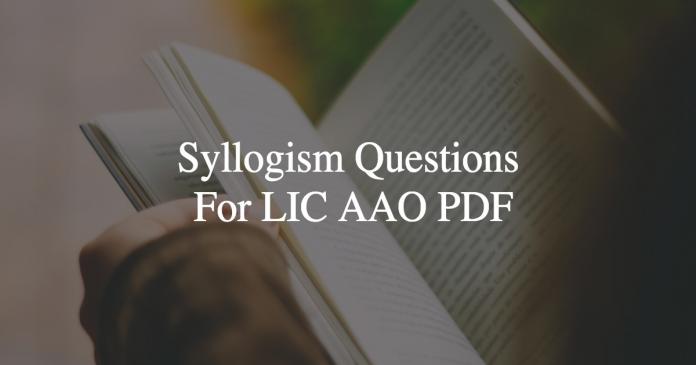Syllogism Questions For LIC AAO PDF
Download syllogism questions for lic aao pdf
10 LIC AAO Mock Tests – Just Rs. 117
Download LIC AAO Previous Papers PDF
Instructions
Below are two statements followed by two conclusions. Assume these statements are true irrespective of whether they are true in real life.
Question 1: Statements: All cells are phones. Some phones are wireless. All wireless are devices.
Conclusion I: Some cells are devices
Conclusion II: Some devices are phones
a) If only conclusion I follows
b) If only conclusion II follows
c) If either conclusion I or II follows
d) If neither conclusion I or II follows
e) If both conclusion I and II follow
Question 2: Statements: All musicians are music lovers. No music lover likes drums.
Conclusion I: No musician likes drum
Conclusion II: All music lovers are musicians
a) If only conclusion I follows
b) If only conclusion II follows
c) If either conclusion I or II follows
d) If neither conclusion I or II follows
e) If both conclusion I and II follow
Question 3: Statements: Some keys are golden. Some files are keys.
Conclusion I: Some files are golden
Conclusion II: All keys are either golden or are files
a) If only conclusion I follows
b) If only conclusion II follows
c) If either conclusion I or II follows
d) If neither conclusion I or II follows
e) If both conclusion I and II follow
Download LIC AAO Previous Papers PDF
100 Free Computer Awareness Tests for LIC
Question 4: Statements: Some teachers are lawyers. All advocates are lawyers.
Conclusion I: Some lawyers are advocates
Conclusion II: Some lawyers are teachers
a) If only conclusion I follows
b) If only conclusion II follows
c) If either conclusion I or II follows
d) If neither conclusion I or II follows
e) If both conclusion I and II follow
Question 5: Statements: Some books are tools. All tools are levers.
Conclusion I: No tool is a book
Conclusion II: Some books are levers
a) If only conclusion I follows
b) If only conclusion II follows
c) If either conclusion I or II follows
d) If neither conclusion I or II follows
e) If both conclusion I and II follow
100 Free GK Tests for Insurance Exams
Instructions
Below are given three statements. Assume these statements are true irrespective of whether they are true in real life. Each question has two conclusions.
Statements:
Some pins are boards.
Some boards are white.
No pin is a box.
Question 6: Conclusion I: Some boxes are not boards
Conclusion II: No pins are white
a) If only conclusion I follows
b) If only conclusion II follows
c) If either conclusion I or II follows
d) If neither conclusion I or II follows
e) If both conclusion I and II follow
Question 7: Conclusion I: Some pins are white
Conclusion II: No box is a board
a) If only conclusion I follows
b) If only conclusion II follows
c) If either conclusion I or II follows
d) If neither conclusion I or II follows
e) If both conclusion I and II follow
Instructions
Below three statements are given. Assume these statements are true irrespective of whether they are true in real life. Each question has two conclusions.
Statements:
All hornets are bees.
Some birds are bees.
No bird is a reptile.
Question 8: Conclusion I: At least some reptiles are bees
Conclusion II: At least some hornets are not reptiles
a) If only conclusion I follows
b) If only conclusion II follows
c) If either conclusion I or II follows
d) If neither conclusion I or II follows
e) If both conclusion I and II follow
Question 9: Conclusion I: Some hornets are not reptiles
Conclusion II: Some birds are not hornets
a) If only conclusion I follows
b) If only conclusion II follows
c) If either conclusion I or II follows
d) If neither conclusion I or II follows
e) If both conclusion I and II follow
Question 10: Conclusion I: Some hornets are birds
Conclusion II: Some bees are not reptiles
a) If only conclusion I follows
b) If only conclusion II follows
c) If either conclusion I or II follows
d) If neither conclusion I or II follows
e) If both conclusion I and II follow
Question 11: In each of the following questions two statements are given and these statements are followed by two conclusions numbered (A) and (B). You have to take the given two statements to be true even if they seem to be at variance from commonly known facts. Read the conclusions and then decide which of the given conclusion logically follows from the two given statements, disregarding commonly known facts.
Statements: Some mangoes are yellow. Some tixo are mangoes.
Conclusions: A. Some mangoes are green.
B. Tixo is yellow.
a) Only (A) conclusion follows
b) Only (B) conclusion follows
c) Either (A) or (B) follows
d) Neither (A) nor (B) follows
Question 12: The logic problems in this set present you with three true statements: Fact A, Fact B and Fact C. Then you are given three more statements (labelled I, II and III), and you must determine which of these, if any, is also a fact. One or two of the statements could be true; all of the statements could be true; or none of the statement could be true. Choose your answer based solely on the information given in the first three facts.
Fact A: All hats have brims.
Fact B: There are black hats and blue hats.
Fact C: Baseball caps are hats
If the first three statements are facts, which of the following statements must also he a fact?
I. All caps have brims
II. Some baseball caps are blue
III. Baseball caps have no brims.
a) I Only
b) II Only
c) II and III Only
d) None of the statements is a known fact.
LIC AAO REASONING QUESTIONS PDF
Instructions
In each question below are two statements followed by two conclusions numbered I and II. You have to take the given statement to be true even if they seems to be at variance from commonly known facts and then decide which of the given conclusion logically follows from the given statements disregarding commonly known facts.
Question 13: Statements: All pencils are pens
No pencil is pin
Conclusions: I. No pin is pencil
At least some pencils are pins.
a) Give answer (a) if only conclusion I follows
b) Give answer (b) if only conclusion II follows
c) Give answer (c)if neither conclusion I or II follows
d) Give answer (d) if neither conclusion I nor II follows
e) Give answer (e) if both conclusion I and II follow
Question 14: Statements: Some songs are longs
All longs are shorts
Conclusions: I. At least some songs are shorts
II. At least some shorts are longs
a) Give answer (a) if only conclusion I follows
b) Give answer (b) if only conclusion II follows
c) Give answer (c)if neither conclusion I or II follows
d) Give answer (d) if neither conclusion I nor II follows
e) Give answer (e) if both conclusion I and II follow
Question 15: Statements: Some songs are longs
All songs are shorts
Conclusions: I. All longs are songs
II. All shorts are longs
a) Give answer (a) if only conclusion I follows
b) Give answer (b) if only conclusion II follows
c) Give answer (c)if neither conclusion I or II follows
d) Give answer (d) if neither conclusion I nor II follows
e) Give answer (e) if both conclusion I and II follow
Question 16: Statements: Some letters are words
Some words are sentences
Conclusions: I. Some letters are sentences
II. At least some sentences are words
a) Give answer (a) if only conclusion I follows
b) Give answer (b) if only conclusion II follows
c) Give answer (c)if neither conclusion I or II follows
d) Give answer (d) if neither conclusion I nor II follows
e) Give answer (e) if both conclusion I and II follow
Question 17: Statements: Some letters are words
Some words are sentences
Conclusions: I. No letter is sentence
II. At least some sentences are letters
a) Give answer (a) if only conclusion I follows
b) Give answer (b) if only conclusion II follows
c) Give answer (c)if neither conclusion I or II follows
d) Give answer (d) if neither conclusion I nor II follows
e) Give answer (e) if both conclusion I and II follow
Question 18: Statements: All letters are words
All words are sentences
Conclusions: I. No letter is sentence.
II. All letters are sentences.
a) Give answer (a) if only conclusion I follows
b) Give answer (b) if only conclusion II follows
c) Give answer (c)if neither conclusion I or II follows
d) Give answer (d) if neither conclusion I nor II follows
e) Give answer (e) if both conclusion I and II follow
Instructions
In the following question three statements are given, followed by two conclusions. You have to consider the statements to be true even if they seem to be at variance from commonly known facts. You have to decide which of the given conclusions, if any, follows from the given statements and select the appropriate option.
Question 19: Statement I: All crows are black
Statement II: Some pigeons are black
Statement III: Some pigeons are bats
Conclusion I: All crows can be pigeons
Conclusion II: All bats can be black
a) Conclusion I only
b) Conclusion II only
c) Both the conclusions follow
d) Either conclusion I or conclusion II follows
e) None of the conclusions follows
Question 20: Statement I: All batsmen are wicket keepers
Statement II: No wicket keeper is a bowler
Statement III: All bowlers are all rounders
Conclusion I: All batsmen being all rounders is not a possibility
Conclusion II: No wicket keeper is an all rounder
a) Conclusion I only
b) Conclusion II only
c) Both the conclusions follow
d) Either conclusion I or conclusion II follows
e) None of the conclusions follows
Download General Science Material PDF
Answers & Solutions:
1) Answer (B)
From the figure below we can see that conclusion I is false. As the subset wireless is a subset of devices and overlaps with the set phones, the set devices must overlap with phones. Hence, some devices are phones.

2) Answer (A)
As musicians is a subset of music lovers and music lovers set and ‘people who like drums’ set does not overlap => musicians and ‘people who like drums’ set cannot overlap. Hence, conclusion I follows. From the figure below we can see that conclusion II is untrue.

3) Answer (D)
From the figure below we can see that both conclusions are false. Hence, option D.

4) Answer (E)
As some teachers are lawyers, by reversing the statement we get some lawyers are teachers. As all advocates are lawyers, some lawyers must be advocates. Hence, both conclusions necessarily follow.
5) Answer (B)
From the figure below we can see that conclusion I is false. As the set tools is a subset of set levers, and books and tools overlap, then books and levers must also overlap. Hence, some books are levers must be true.

6) Answer (D)
The figure below shows a case when both conclusions are untrue. Hence, option d.

7) Answer (D)
The figure below shows a case when both conclusions are not true. Hence, option D.

8) Answer (C)
In the figure on the left, we see that the conclusion I does not follow. In the figure on the right, we see that the conclusion II does not follow. However, both cases cannot exist at the same time. Either one or the other of the two conclusions must be true. Hence, option C.

9) Answer (C)
From the figure on the left we can see a case when conclusion I isn’t true. Hence, conclusion I does not follow. From the figure on the left we can see a case when conclusion II isn’t true. Hence, conclusion II does not follow. For I to be untrue, All hornets should be reptiles. Hence, the set hornets should be a subset of the set reptiles. Hence, the set hornets cannot overlap with the set birds. Hence, some birds will not be hornets. The cases shown below are mutually exclusive. If one occurs the other cannot occur and vice versa. Hence, either conclusion I or II follows.

10) Answer (B)
From figure on the left we can see that the conclusion is not true in the case shown. Hence conclusion 1 does not follow. From the figure on the right, we can see that we cannot draw the set reptiles to encase all bees as it cannot overlap with the set birds. Hence, some bees will not be reptiles. Hence, conclusion II follows.

11) Answer (D)
The data given to us:
Statements: Some mangoes are yellow. Some tixo are mangoes.
This can be intrepreted as:
Conclusions: A. Some mangoes are green which is a wrong conclusiom
B. Tixo is yellow which is again a wrong conclusion.
Neither I or II follow.
12) Answer (B)
The only statement which will be a fact is ‘Some baseball caps are blue’.
All baseball caps are hats. Hats are of two colours blue and black.
Therefore, some baseball caps are blue.
Hence, only statement II is true.
13) Answer (C)
14) Answer (E)
15) Answer (D)
16) Answer (B)
17) Answer (C)
18) Answer (B)
19) Answer (C)

From the diagram, we can see that All crows can be pigeons and All bats can be black.
Hence, option C is the correct answer.
20) Answer (E)

From the diagram, we can see that all batsmen being all rounder is a possibility and some wicket keepers can be all rounders.
Hence, option E is the correct answer.





